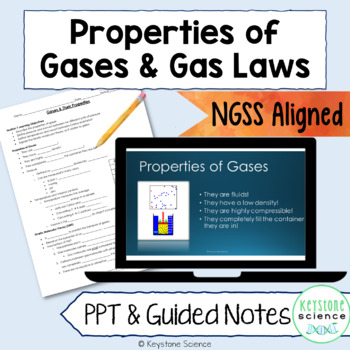Properties of Gases Gas Laws PowerPoint with Guided Notes NGSS Boyles Charles
- Zip
Also included in
- The properties of gases and gas laws unit will practically teach itself! In this bundle are two of my best-selling products that will supplement your chemistry curriculum. My interactive and highly visual PPT presentation with information on the properties of gases and ALL the gas laws is included aPrice $8.00Original Price $9.50Save $1.50
Description
If you are looking to a COMPLETE PowerPoint and student guided note-taking sheet for the characteristics and properties of gases, pressure and temperature conversions, and ALL gas laws, this is it! The PowerPoint includes vibrant diagrams and animations for your visual learners with inquiry-driven, interactive note-taking activities embedded in the presentation. PowerPoint is animated with teaching notes and tips.
Topics covered include: characteristics and properties of gases, temperature and pressure conversions, kinetic molecule theory, Boyle's law, Charles' law, Gay-Lussac's law, Avogadro's law, Combined gas law, Ideal gas law, diffusion and effusion, and Graham's law.
Included with your purchase: flattened PPT file with teacher notes, PDF with student notes and teacher answer key.
Learning Objectives:
- Describe the properties of gases
- Define pressure and convert between the different units of pressure
- Define temperature and convert between Celsius and Kelvin
- Explain the kinetic molecule theory as it relates to gases
- Explain the relationship between pressure and volume (Boyle's Law) and solve problems using these variables
- Explain the relationship between volume and temperature (Charles' Law) and solve problems using these variables
- Explain the relationship between pressure and temperature (Gay-Lussac's Law) and solve problems using these variables
- Explain the relationship between moles and volume (Avogadro's Law) and solve problems using these variables
- Explain how Boyle's Charles;, Gay-Lussac's, and Avogadro's laws combine to form the Ideal Gas Law
- Explain the properties of an ideal gas
- Solve problems using the ideal gas law formula
- Explain the relationship between gas velocity and the mass of a gas molecule (Graham's Law) and solve problems using these variables
Related Products
⭐ Pressure, Temperature, Mole, Liters Gas Laws Conversion Worksheet with Key
⭐ Chemistry Gas Laws Packet Massive Problem Set ANSWER KEY INCLUDED
⭐ Charles' Law Problems with Answer Key Chemistry Gas Laws
⭐ Chemistry Combined Gas Law Problems with Answer Key
⭐ Ideal Gas Law Worksheet and Answer Key Chemistry
⭐ Mixed Gas Law Problem Worksheet Chemistry
⭐ Graham's Law Problems with Answer Key Chemistry Gas Laws
Customer Tips
How to get TPT credit to use on future purchases
Please go to your My Purchases page (you may need to login). Beside each purchase you'll see a Provide Feedback button. Simply click it and you will be taken to a page where you can give a quick rating and leave a short comment for the product. Each time you give feedback, TPT gives you feedback credits that you use to lower the cost of your future purchases. I value your feedback greatly as it helps me determine which products are most valuable for your classroom so I can create more for you. ☺
Be the first to know about my new discounts, freebies and product launches
Look for the green star next to my store logo and click it to become a follower. Voila! You will now receive email updates about this store. ☺






